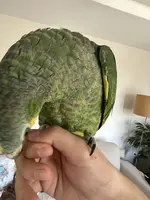Navigation
Install the app
How to install the app on iOS
Follow along with the video below to see how to install our site as a web app on your home screen.
Note: This feature may not be available in some browsers.
More options
Style variation
You are using an out of date browser. It may not display this or other websites correctly.
You should upgrade or use an alternative browser.
You should upgrade or use an alternative browser.
Is my amazon a good weight?
- Thread starter Lorenco
- Start date
After taking a quick glance on google, seems like the average weight is anywhere from 340-400 grams. Some have the highest range at 470! Hopefully someone with more Amazon experience can give a better answer.
Lorenzo sure is beautiful though.
Lorenzo sure is beautiful though.
Bird&Ant lover
Active member
- Jul 23, 2024
- 73
- 149
- Parrots
- Ginger, budgie ( 3 3/4 years old)
Sari, cockatiel (1 1/2 year old)
Kiwi, budgie ( 7~ months old)
Rest in peace Bella, budgie 2021-2024
Died of tumor in liver
It seems this bird should weigh between 360-400 Grams
Given weights in short descriptions of a parrot species are just observed ranges. There are wide ranges of weights and size within any given species, just as there are with human beings. So don't fret much about the total weight of your parrot. In example, Salty's species, yellow shoulder Amazon, those websites say the range is 280-320gr. But Salty weighs in at 340 and has for many years. He is also bigger in stature then other YSA we have met.
However, do monitor his weight regularly, say 3 or4 times a week, or more. Keep a journal of the results. WHY? Parrots will ALWAYS try to hide outward signs of illness, which is normal for any prey animal, and parrots are prey. Thats because in the wild, the ill or sick parrots are the first to be predated upon. The one thing parrots cannot hide is losing weight when sick or ill. A drop of more then, oh, 2-5% over a few days is cause for concern and a vet visit is in order.
Also, you can determine how much of that weight is fat and how much is muscle. Holding the bird firmly but gently, feel around on his chest for his keel bone. If it is sticking out or is very prominent when you feel for it, the bird is underweight. If it feels like it is firm, not only directly on the keel bone but in the adjacent areas, that is flight muscle. If it feels sort squishy, its likely fats.
However, do monitor his weight regularly, say 3 or4 times a week, or more. Keep a journal of the results. WHY? Parrots will ALWAYS try to hide outward signs of illness, which is normal for any prey animal, and parrots are prey. Thats because in the wild, the ill or sick parrots are the first to be predated upon. The one thing parrots cannot hide is losing weight when sick or ill. A drop of more then, oh, 2-5% over a few days is cause for concern and a vet visit is in order.
Also, you can determine how much of that weight is fat and how much is muscle. Holding the bird firmly but gently, feel around on his chest for his keel bone. If it is sticking out or is very prominent when you feel for it, the bird is underweight. If it feels like it is firm, not only directly on the keel bone but in the adjacent areas, that is flight muscle. If it feels sort squishy, its likely fats.
- Apr 24, 2018
- 17,282
- 31,728
- Parrots
- Tucker the Red Sided Eclectus
Baxter the YNA
Avery the CAG
Patches the Grand Eclectus, my best friend. RIP
Cuckoo the BFA RIP
Average ranges are great and all, but a healthy weight is whatever is right for each individual. Your vet is the one to ask when doing a physical exam. Feel his keel bone. Here's a chart of what to look for.

As mentioned above, keeping regular track of weight over time can often be your only indicator of ailments, so it's important to know where he's at. I don't have experience with orange wings, other than I've met a few. My YNA is a big girl, a little on the chunky side, but has been stable at 640-650g for years.
As mentioned above, keeping regular track of weight over time can often be your only indicator of ailments, so it's important to know where he's at. I don't have experience with orange wings, other than I've met a few. My YNA is a big girl, a little on the chunky side, but has been stable at 640-650g for years.
Most Reactions
-
 665
665 -
 484
484 -
 453
453 -
 300
300 -
 249
249 -
 248
248 -
 190
190 -
 174
174 -
 164
164 -
 158
158 -
 87
87 -
J
84
-
 81
81 -
 70
70 -
 43
43
Similar threads
- Replies
- 6
- Views
- 2K
- Replies
- 10
- Views
- 889




